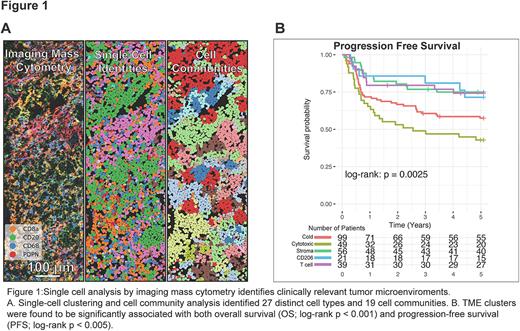Abstract
Diffuse large B-cell lymphoma is a heterogeneous disease with established patterns of recurrent molecular and genetic features. However, we have limited understanding of the cellular composition of DLBCL tumors and the underlying biology of the tumor microenvironment (TME). Here we used imaging mass cytometry to simultaneously quantify 2 sets of 34 protein markers across serial sections of tumor tissues. Altogether, 57 unique markers identifying major cell lineages (CD3, CD20, PDPN, CD68, etc.), immune function (IDO, PD1, Granzyme B, etc.) and tumor phenotypes (IRF4, BCL6, p53, etc.) were quantified at single-cell resolution across 545 tumor cores from 328 primary DLBCL tumors.
Single-cell clustering and cell community analysis identified 27 distinct cell types and 19 cell communities with 5 overarching patterns of tumor composition and structure (Fig. 1A). "Cold" microenvironments, tumors depleted of infiltrating immune and stromal cells, were the most frequent and accounted for 35.1% (n=115) of the imaged tumors. "Cytotoxic" TMEs (20.7%, n=68) were significantly enriched for CD8 T cells expressing granzyme B and LAG3, as well as CD163+ M2-like macrophages expressing IDO and S100A9. "Stromal" tumors (21.3%, n=70) were enriched for PDPN-positive stroma and M1-like macrophages. The "CD206" TMEs (8.2%, n=27) were enriched for CD206+ M2-like macrophages and Tregs. The "T cell" TMEs (14.6%, n=48) were depleted of macrophages and significantly enriched for CD4 T cells and Tregs. Separately, we also found that 98% (213/217) of cases with replicate tumor cores did not have statistically meaningful differences in tumor composition between cores (chi-squared: p-value >0.05).
Multivariate Cox proportional hazard analysis (Fig. 1B) found the TME clusters to be significantly associated with both overall survival (OS; log-rank p < 0.001) and progression-free survival (PFS; log-rank p < 0.005). Notably, the cytotoxic TMEs were found to manifest the most unfavorable clinical outcomes (OS; HR = 2.69; 95% CI: 1.26-5.35; p-value < 0.001), whereas the cold tumors featured a modest trend towards inferior survival (OS; HR=1.5; 95% CI: 0.76-3.01; p-value <0.25). The remaining TME clusters were found to have comparably superior outcomes. Importantly, after correcting for cell of origin (COO) and IPI score, cytotoxic TMEs maintained significant association with inferior OS (HR = 1.78; 95% CI: 1.06-2.98; p-value < 0.05) and PFS (HR=1.85; 95% CI: 1.18-2.90, p-value < 0.01). Furthermore, cytotoxic TMEs were found to be significantly enriched in patients with stage III & IV disease (p-adj <0.001; 76% vs 36%-50% in other TMEs). We developed machine learning frameworks to reproduce the TME classifications with a significantly reduced feature set. Random forest classifiers achieved an overall multiclass classification accuracy of 84% (individual classes 74%-90%) with features from 7 biomarkers.
We evaluated 23 phenotypic markers of the malignant B-cell populations for relationships with the TME. Malignant B cells in the cytotoxic TMEs had significantly elevated MHC-I, PD-L1, and vimentin expression (p-adj <0.01) and were enriched with ABC-like DLBCLs (50% vs. 27% in other TMEs; p-adj <0.05). Cold TMEs had significantly elevated BCL2 and Ki67 proliferative index, and lower MHC-I expression. Stroma TMEs were enriched with GCB-like DLBCLs (75.0% vs 53.3% in other TMEs; p-adj <0.01).
Consistent with this, we found the BCL2-MYC 'double-hit' signature and the 'EZB-MYC+' LymphGen genetic group to be significantly enriched in cold TMEs (p-adj <0.001), with 68.2% of EZB-MYC+ belonging to the cold cluster. The MCD LymphGen class was also significantly associated with TME compositions (Fisher's test: p-value <0.01); however, it was predominately split between cold (50.0%) and cytotoxic (36.4%) TMEs. There were no MCD cases presenting the 'Stroma' or 'T cell' TME.
In summary, we present the first comprehensive assessment of the molecular and cellular landscape of DLBCL by highly multiplexed imaging. Collectively, these results suggest the cold and cytotoxic TMEs may represent a dichotomy of 2 divergent paths to aggressive disease, either extreme immune dysfunction (cytotoxic) or evasion (cold). Identifying TME compositions in patients will improve patient stratification and may provide helpful context for the milieu of immune engaging therapies currently being evaluated for the treatment of DLBCL.
Disclosures
Steidl:Abbvie: Consultancy; Bayer: Consultancy; Bristol Myers Squibb: Consultancy; Curis Inc: Consultancy; Epizyme: Research Funding; Roche: Consultancy; Seattle Genetics: Consultancy; Trillium Therapeutics: Research Funding. Scott:AstraZeneca: Consultancy, Honoraria; Incyte: Consultancy; Janssen: Consultancy, Research Funding; Roche: Research Funding; NanoString: Patents & Royalties; Abbvie: Consultancy. Elemento:Johnson and Johnson: Research Funding; AstraZeneca: Research Funding; Volastra Therapeutics: Consultancy, Current equity holder in publicly-traded company, Research Funding; Eli Lilly: Research Funding; Freenome: Consultancy, Other: Current equity holder in a privately-held company; Janssen: Research Funding; Owkin: Consultancy, Current equity holder in publicly-traded company; One Three Biotech: Consultancy, Current equity holder in publicly-traded company; Champions Oncology: Consultancy.
Author notes
Asterisk with author names denotes non-ASH members.


This feature is available to Subscribers Only
Sign In or Create an Account Close Modal